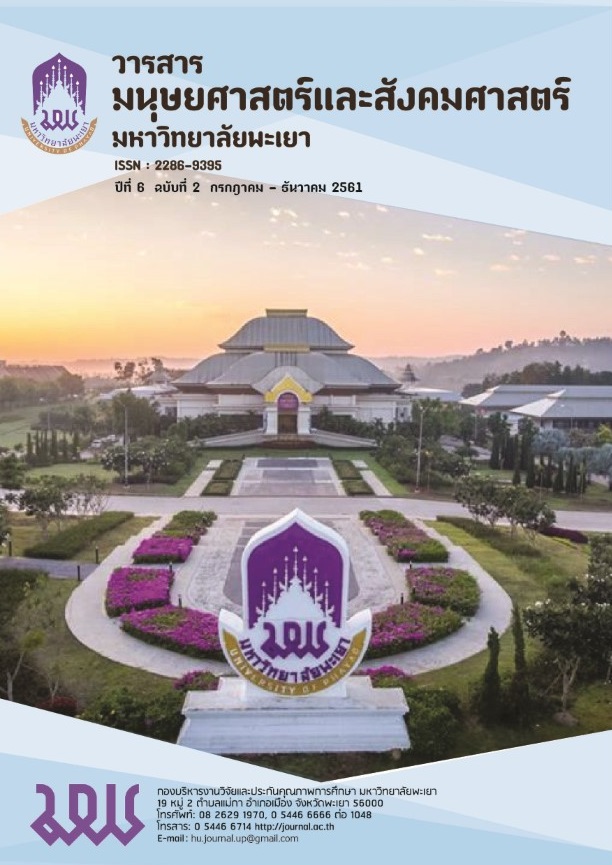A model of Phayao tourism Image Management
Abstract
Study of Model of Tourism Image Management of Phayao Province. The objective of this study was to study the tourism image management of Phayao Province for tourism development. Quantitative tool was compiled to Thai tourist questionnaire and qualitative tools are documentary, non-participant observation, interview and small group discussion with public, private and community tourism organization. The quantitative result with 400 tourists showed that most sample are women with 53.0 %, 36.5 % aged between 21 and 30 years old. 31.5% were income more than 30,000 bath, 60 % came to visit during the weekend and with the family of 30.5 %. The result of Phayao tourism image revealed that top four tourism destination are cultural, natural, agricultural and border tourism respectively. Tourists were recognizing the image of the Internet through social media reviews. The issue was the nature tourism and culture around Phayao lake. The tourism will travelling in city area and will come tourism festival period..The result of small group discussion with 20 participants include public, private and community tourism organization. Conclusion drawn for the study was the image of should create a 360 degree tourism to tourists to visit the whole year. And focus on public relations for Phayao tourism which emphasize on peace, good health, long stay, diversity of culture. Then organization work with the public, private, community and educational sectors to drive tourism Image Management.
References
_________ . (2549). ผลการวิจัยเรื่อง โครงการศึกษาวิจัยเพื่อหาความต้องการฝึกอบรมด้านการตลาดท่องเที่ยว. กรุงเทพฯ: การท่องเที่ยวแห่งประเทศไทย.
_________ . (2556). จุลสารการท่องเที่ยวฉบับที่3/2556. [ระบบออนไลน์]. แหล่งที่มา: http://www.etatjournal.com/web/menu-read-web-etatjournal
กรมการท่องเที่ยว. (2556). สรุปสถานการณ์นักท่องเที่ยวชาวต่างชาติ ปี พ.ศ. 2555 และแนวโน้ม ปี พ.ศ. 2556. [ระบบออนไลน์]. แหล่งที่มา : http://123.242.133.66tourism/th/home/download_list.php?gid=4
กระทรวงการท่องเที่ยวและกีฬา. (2546). รายงานประจำปี 2545. กรุงเทพฯ: กระทรวงการท่องเที่ยวและกีฬา.
ฉลองศรี พิมลสมพงศ์. (2548). การวางแผนการท่องเที่ยว. พิมพ์ครั้งที่ 5. กรุงเทพฯ: สำนักพิมพ์ เกษตรศาสตร์.
จังหวัดพะเยา. (2556). ข้อมูลด้านการท่องเที่ยวจังหวัดพะเยา. [ระบบออนไลน์]. แหล่งที่มา: http://www.phayao.go.th/au/c4-3.php
ชาย โพธิสิตา. (2549). ศาสตร์และศิลป์แห่งการวิจัยเชิงคุณภาพ. กรุงเทพฯ: อมรินทร์พรินติ้ง.
บุญเลิศ จิตตั้งวัฒนา. (2548). อุตสาหกรรมการท่องเที่ยว. กรุงเทพฯ: เพรส แอนด์ ดีไซน์.
วารัชต์ มัธยมบุรุษ. (2552). รูปแบบการบริหารจัดการการท่องเที่ยวของนักท่องเที่ยวชาวญี่ปุ่นที่พำนักระยะยาวในจังหวัดเชียงใหม่. เชียงใหม่: มหาวิทยาลัยแม่โจ้.
วารัชต์ มัธยมบุรุษ. (2554). การพัฒนาเส้นทางการท่องเที่ยวเพื่อการเรียนรู้อย่างมีส่วนร่วม สำหรับนักท่องเที่ยวผู้สูงอายุ กรณีศึกษาพื้นที่การไฟฟ้าฝ่ายผลิตแม่เมาะและชุมชนรอบ จังหวัดลำปาง. เครือข่ายบริหารการวิจัยภาคเหนือตอนบน สำนักงานคณะกรรมการการอุดมศึกษาปีงบประมาณ 2553.
ศุภลักษณ์ อังครางกูร. (2548). พฤติกรรมนักท่องเที่ยว. พิมพ์ครั้งที่ 2. ขอนแก่น: โรงพิมพ์คลังนานาวิทยา.
สุชาต ประสิทธิ์รัฐสินธุ์. (2540). ระเบียบวิธีการวิจัยทางสังคมศาสตร์. กรุงเทพฯ: สามลดา.
Cooper, Chris. , Gilvert, David. ,Fyall, Alan. , Fletcher, John and Wanhill, Stephen. (2005). Tourism: Principles and Practices. 3rded. London: Pearson Education.
Goeldner, Charles R. and Ritchie, J.R. Brent. (2012). Tourism: Principles, Practices, Philosophies. 12th ed. NewYork: John Wiley & Sons.
GHall, C.Michael and Page, Stephen J.. (2002). The geography of tourism and recreation. 2nd ed. Kentucky: Routledge.
March, Roger St Georrge and Woodside, Arch G.. (2005). Tourism Behavior: Travelers’ Decisions and Actions. Massachusetts: Pul CABI.
Ross, Glenn F.. (1998). The Psychology of Tourism. 2nd ed. Melbourne: Hospitality Press.
Swarbrooke, John and Horner, Susan. (2005). Consumer behaviour in tourism. 2nd ed. London: Butterworth-Heinemann.
Downloads
Published
How to Cite
Issue
Section
License
ผู้นิพนธ์ต้องรับผิดชอบข้อความในบทนิพนธ์ของตน มหาวิทยาลัยพะเยาไม่จำเป็นต้องเห็นด้วยกับบทความที่ตีพิมพ์เสมอไป ผู้สนใจสามารถคัดลอก และนำไปใช้ได้ แต่จะต้องขออนุมัติเจ้าของ และได้รับการอนุมัติเป็นลายลักษณ์อักษรก่อน พร้อมกับมีการอ้างอิงและกล่าวคำขอบคุณให้ถูกต้องด้วย
The authors are themselves responsible for their contents. Signed articles may not always reflect the opinion of University of Phayao. The articles can be reproduced and reprinted, provided that permission is given by the authors and acknowledgement must be given.








